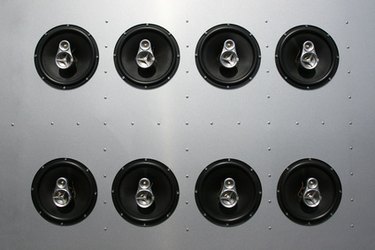
There are two ways to wire four speakers to a two channel amplifier: in series or in parallel. Which one to choose depends on both the speakers and the amplifier, specifically their impedance levels and limits. Wiring speakers in series raises the impedance delivered to the amplifier, while wiring them in parallel lowers it. Amplifiers have both a minimum and a maximum level of impedance and it is important to stay within these limits.
Determining Which Method to Use
Video of the Day
Step 1
Determine the minimum and maximum impedance levels of the amplifier–measured in ohms–by referring to its manual.
Video of the Day
Step 2
Determine the impedance of the speakers by reading the label on the speaker itself or by checking their manual.
Step 3
Add the impedance levels of the two left speakers together. If the sum is within the limits of your amplifier, wire the speakers in series; if it is not, continue to step 4.
Step 4
Multiply the impedance levels of the two left speakers. Divide this number by the number from step 3. If the quotient is within the limits of your amplifier, wire the speakers in parallel; if it is not, you will not be able to use the speakers with your amplifier.
Wiring in Series
Step 1
Connect a wire from the left positive terminal of the amplifier to the positive terminal of one of the left speakers.
Step 2
Connect a wire from the negative terminal of the same speaker to the positive terminal of the other left speaker.
Step 3
Connect a wire from the negative terminal of the second left speaker to the left negative terminal of the amplifier.
Step 4
Repeat for the right pair of speakers.
Wiring in Parallel
Step 1
Connect wires from the left positive and negative terminals of the amplifier to the corresponding terminals of one of the left speakers.
Step 2
Connect another pair of wires from the same positive and negative terminals of the amplifier to the corresponding terminals of the other left speaker.
Step 3
Repeat for the right pair of speakers.